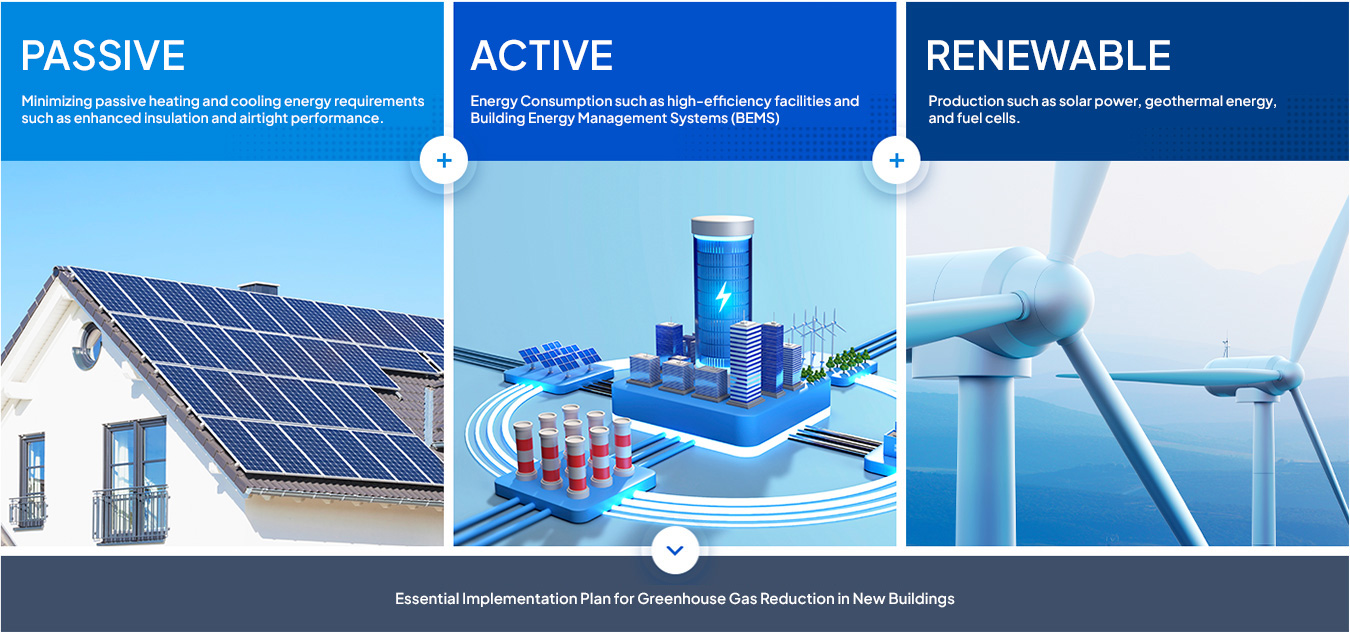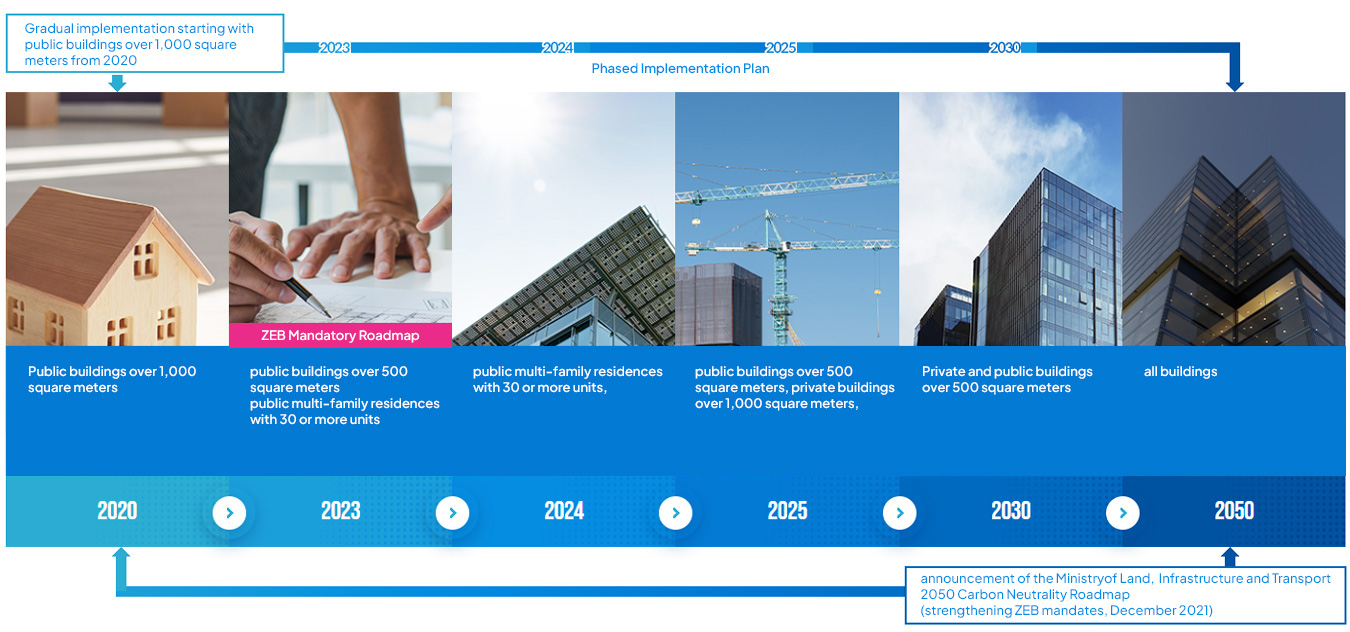SUPPORT POLICIES
Korea Energy Agency Building Support Program
Objective
The program aims to promote the commercialization of newly developed renewable energy technologies by providing partial government subsidies for the installation of renewable energy facilities. Additionally, it seeks to stimulate the widespread adoption of commercialized technologies, fostering the creation and expansion of the renewable energy market.
What is the Building Support Program?
A large-scale distribution program targeting private users for commercialized renewable energy systems.
Eligibility
All buildings and facilities, except for those defined under Article 21 (housing) and Article 26 (buildings and facilities owned or managed by local governments) of the Ministry of Trade, Industry, and Energy’s regulations on the “Support for Renewable Energy Systems.”
Scope of Support
| Category | Support Scope (Per Unit Project) |
Support Budget (Million KRW) |
Subsidy Unit Price (KRW, VAT Included) |
Notes | ||
|---|---|---|---|---|---|---|
| Solar Power (Fixed) | General | 100kW or less | 12,429 | Standard Modules | 741/kW | – |
| Low-Carbon Modules, | 867/kW | |||||
| Livestock Facilities | Standard Modules | 849/kW | ||||
| Low-Carbon Modules | 999/kW | |||||
| Building-Integrated (BIPV) | – | 7,868 | Separate Review |
Preferential support of up to 70% (50% for roof installations, 70% for wall installations) |
||
| Design Subsidies | 337 | Separate Review |
at 3% of the total project cost, with a maximum limit of 25 million KRW. | |||
Process
Support program experts review and assist with the entire process, from application to approval and construction preparation.
Review, Application preparation
Conduct feasibility reviews, Prepare application documents
Submit the support program application
Submit to the Korea Energy Agency
The announcement by the review committee
Project selection and construction
Agency project approval, Construction preparation
Agency advance payment
Project completion
Facility installation verification
Subsidy disbursement
Public institution installation obligation program
Objective
Regarding buildings with a building area of 1,000 m2 or more that are newly built, expanded, or remodeled by public institutions such as the government or local governments.
Mandatory installation of new and renewable facilities to use energy supplied through new and renewable energy above a certain percentage Buildings subject to mandatory installation
Buildings subject to mandatory installation
Buildings are subject to the installation obligation if they are constructed, expanded, or remodeled with a total floor area of 1,000㎡ or more by an institution specified under Article 12(2) of the Act on the Promotion of Renewable Energy Development, Utilization, and Supply, and fall under the designated use cases outlined in Article 15(1)(1) of the Act’s Enforcement Decree.
* All three criteria below must be met to qualify as an installation-required building.
| Target Entities | Criteria |
|---|---|
| Target Institutions (Building Owners) | National and Local Governments Public institutions as defined under Article 4 of the Act on the Management of Public Institutions Government-funded institutions receiving annual contributions of 5 billion KRW or more from the government. Government-invested companies as defined under Article 2(6) of the National Property Act Corporations in which local governments, public institutions, government-funded institutions, or government-invested companies hold an investment proportion or an amount specified specified by Presidential Decree. (50% of paid-in capital) Corporations with an investment of 5 billion KRW or more in paid-in capital. Corporations established under special laws |
| Building Types Eligible for Renewable Energy Installation | Cultural and assembly facilities, Religious facilities, Retail facilities, Transportation facilities, Medical facilities, Educational and research facilities, Facilities for older persons and children, Training facilities, Sports facilities, Office facilities, Accommodation facilities, Entertainment facilities, Correctional facilities (excluding military and defense facilities), Broadcasting and communication facilities, Cemetery-related facilities, Tourist rest facilities and funeral facilities |
| Total Floor Area of Eligible Buildings | Each building being newly constructed, expanded, or remodeled must have a total floor area of 1,000㎡ or more. |
Unit Energy Production and Source-specific Correction Factors
| Renewable Energy Sources | Unit Energy Production | Source-specific Correction Factors | ||
|---|---|---|---|---|
| Solar power | Fixed type | 1,358 | kWh/kW・yr | 0.95 |
| Tracking type | 1,765 | 1.47 | ||
| BIPV | 923 | 6.12 | ||
| Solar thermal | Vacuum tube type | 745 | 1.42 | |
| Geothermal, | Vertically sealed type | 864 | 1.26 | |
| Fuel cells | PEMFC (using LNG as fuel)) | 7,415 | 2.20 | |
Business Procedures
Installation Plan Application
Submitted by the obligated institution
Review and Issuance of Results
Renewable Energy Center
Issues results within 30 days of application
Building Permit
Issued by the local government authority
Review results attached
Installation and Installation Verification Application
Obligated institution
Submit within 30 days after installation
Installation Verification
Renewable Energy Center
Issuance of Installation Verification Certificate
Renewable Energy Center
Issues within 15 days of application
Zero Energy Buildings (ZEB)
What is a Zero Energy Building (ZEB)?
A zero-energy building (ZEB) is a green building that minimizes the energy load required by the structure and uses renewable and new energy sources to reduce energy consumption.

Zero Energy Building (ZEB) Certification
Overview
The ZEB certification is awarded to green buildings that are designed to minimize the energy load required by the structure and to minimize energy consumption by utilizing new and renewable energy sources. The certification grades buildings from Level 1 to 5 based on their energy self-sufficiency rate.
Legal Basis
Article 17 of the “Green Building Promotion Act” (Certification of Building Energy Efficiency Grades and Zero Energy Buildings)
Article 12 of the Enforcement Decree of the “Green Building Promotion Act” (Target buildings for Certification of Building Energy Efficiency Grades and Zero Energy Buildings)
Rules on Certification of Building Energy Efficiency Grades and Zero Energy Buildings
(Ministry of Land, Infrastructure and Transport) Standards for Certification of Building EnergyEfficiency Grades and Zero Energy Buildings
ZEB Certification Standards
Buildings must achieve an energy efficiency rating of 1++ or higher
- Evaluated using the Building Energy Analysis Program (ECO2)
- Residential: Less than 90 kWh/㎡, Non-residential: Less than 140 kWh/㎡
Energy self-sufficiency rate must be 20% or higher
- Evaluation using the Building Energy Analysis Program (ECO2)
- Percentage of Renewable Energy Production in Building Energy Consumption
Installation of BEMS or remote reading electronic meters
- The checklist evaluates whether each item is applied
- A system that measures and manages energy consumption in real-time
ZEB Certification Grades and Incentives
| ZEB Rating | Energy Self-Sufficiency Ratio | Additional Construction Costs by Rating | Relaxed Building Standards |
|---|---|---|---|
| 1Rating | Self-Sufficiency Ratio 100% ↑ | 17.7% ↑ | 15% |
| 2Rating | Self-Sufficiency Ratio 80% ~ 100% | 14.8% ↑ | 14% |
| 3Rating | Self-Sufficiency Ratio 60% ~ 80% | 11.8% ↑ | 13% |
| 4Rating | Self-Sufficiency Ratio 40% ~ 60% | 8.6% ↑ | 12% |
| 5Rating | Self-Sufficiency Ratio 20% ~ 40% | 5.4% ↑ | 11% |
Acquisition Tax Reduction up to 20%
National Housing Fund Loan Limit Increase by 20%
Additional Points for Renewable Energy Installation Subsidies
Infrastructure Contribution Rate in Housing Construction Projects
Up to 15% Reduction
ZEB Mandatory Roadmap
